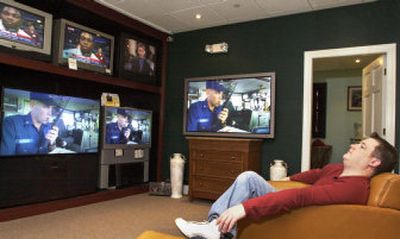Another great thing about slim-line TV: A lot more floor space

Just in time for football season and the new television lineup, Jeff Joseph dumped a hulking, 47-inch cathode ray TV and cabinet in favor of a slim, 43-inch, plasma-screen model in the Arlington, Va., home he shares with his wife and children.
A self-described “tech geek” with a weakness for the latest in home gadgetry — he works for the Consumer Electronics Association, after all — Joseph was drawn to the $4,000 TV’s high-definition picture, its killer sound system and, equally important, its mere seven-inch profile.
Mounting it on a wall allowed him to reclaim a big chunk of the family room, he says. The old TV and the cabinet it rested atop — both of which he gave to a colleague — occupied the space of “one and a half Barcaloungers.”
His wife, Lisa Mernan, is equally blunt. The old set, she says, was like “a Volkswagen parked in our small Arlington house. Now it’s like the room doubled in size. And the new TV is on the wall, so the kids can’t put their little hands on the screen.”
For decades, Americans have arranged their most lived-in rooms around the television. Never mind household traffic patterns, or aesthetic balance, or the belief that furniture should be arranged to encourage good conversation as much as good views of a hot sitcom or an NFL game. The TV set ruled, carefully angled to avoid window glare, heating vents or radiators. Design magazines weren’t much help either, because they rarely show TVs at all.
Advancing technology is beginning to change all that, making slimmer, lighter, good-looking television sets that are less an obstacle and more a flexible accessory. Large and small models alike can perch on tabletops or cabinetry, be mounted almost flush against a wall or affixed to an articulated, swing-out arm.
As the price of flat-panel televisions gradually drifts down to the mainstream market, consumers are looking beyond the bulky behemoths that caused such decorating distortion — particularly in small spaces. Older, boxier sets get exiled (to basements, to homes of family and friends, to yard sales) along with the humongous armoires designed to hold (and hide) the TV and its tangle of accessories. These commanding storage closets, often measuring six feet wide, three feet deep and eight feet tall, dictated the placement of virtually every other piece of furniture in a room.
“Flat-panel TVs solve problems. They give us more choices so you don’t have to take up floor space,” says Washington designer Susan Vallon, who has put them on clients’ walls in virtually every room of the house and even tucked one inside a low chest at the foot of a bed for a couple who raise and lower it by remote control.
Designer Marlies Venute, of McLean, Va., not only helps clients retrofit existing homes for snazzy screens, she also works with architects and builders to plan the placement of flat-panel televisions during new home construction.
A favorite spot is above the fireplace, already considered the focal point of a room by many people. Such placement treats the set almost as a piece of art, which explains why several companies now offer screen savers for flat-panels that range from Impressionist masterpieces to an aquarium filled with exotic fish.
“You create a niche in the brickwork or stone that is the exact size of the screen and about four inches deep so that it is almost flush with the wall. And to keep it from possibly being damaged by heat, you have a mantelpiece of the same material that protrudes 12 or 14 inches,” says Venute. That means all the wiring can be hidden from day one.
The high cost of flat panels has meant that cathode ray tube TVs are still the biggest sellers, with a 27-inch screen averaging $275, says Sean Wargo, of the Arlington-based Consumer Electronics Association.
But slim TVs — including large plasma screens and smaller liquid-crystal display screens — are starting to make inroads as prices drop. Since 2001, the average cost of plasma screens (the “sweet spot” for top sellers is about 42 inches, says Wargo) has plummeted by more than 75 percent, from $9,400 to about $2,300. In that same period, LCD screens (most popular in the low-20-inches) have fallen by almost half, from an average of $1,600 to $870.
Vallon attributes the slim-line craze in part to changes in television viewing habits in a country with 285 million sets, or 2.6 per household.
“People used to just watch news, sports, other shows in one or two rooms of the house. Now you have CNN, talking heads, 24 hours a day. People keep the TV on longer and in more rooms at once so as not to miss anything. You can’t tell people they can’t watch TV where they want to,” says Vallon, who often places small, thin TVs under her clients’ kitchen cabinets and even on bathroom walls.
Furniture manufacturers have taken note, offering everything from inexpensive, assemble-it-yourself TV stands and entertainment centers with twin bookcases and glass doors to high-end consoles and wall systems that conceal the screen when it’s not in use.
Last spring, Sligh Furniture Co. of Holland, Mich., unveiled a “sliding bookcase” system to hide a 42-inch plasma screen behind two-inch-deep shelves filled with fake books. The false front raises vertically like a window in a unit that is as wide and tall as an armoire (65 by 91 inches) but, at just 22 inches deep, not nearly as bulky. It retails for about $5,000. The Neiman Marcus online catalogue for fall includes a $2,169, two-door plasma TV cabinet measuring an anorexic 17 inches deep, while Ikea offers a $50 triangular steel-and-glass corner TV bench on wheels that’s 18 1/8 inches deep.